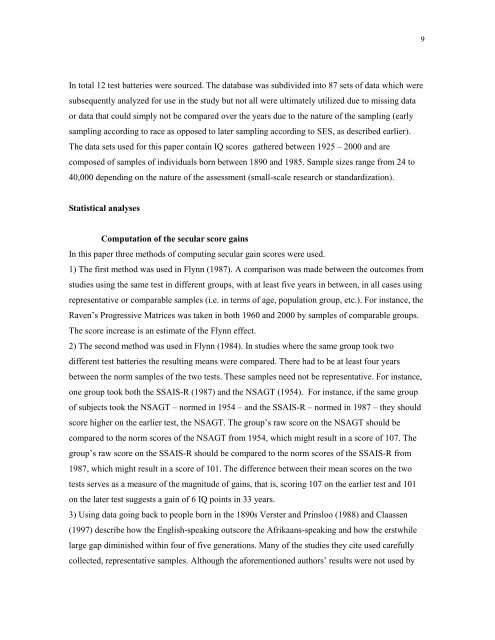The Flynn effect in South Africa - CORA - University College Cork
The Flynn effect in South Africa - CORA - University College Cork
The Flynn effect in South Africa - CORA - University College Cork
Create successful ePaper yourself
Turn your PDF publications into a flip-book with our unique Google optimized e-Paper software.
In total 12 test batteries were sourced. <strong>The</strong> database was subdivided <strong>in</strong>to 87 sets of data which were<br />
subsequently analyzed for use <strong>in</strong> the study but not all were ultimately utilized due to miss<strong>in</strong>g data<br />
or data that could simply not be compared over the years due to the nature of the sampl<strong>in</strong>g (early<br />
sampl<strong>in</strong>g accord<strong>in</strong>g to race as opposed to later sampl<strong>in</strong>g accord<strong>in</strong>g to SES, as described earlier).<br />
<strong>The</strong> data sets used for this paper conta<strong>in</strong> IQ scores gathered between 1925 – 2000 and are<br />
composed of samples of <strong>in</strong>dividuals born between 1890 and 1985. Sample sizes range from 24 to<br />
40,000 depend<strong>in</strong>g on the nature of the assessment (small-scale research or standardization).<br />
Statistical analyses<br />
Computation of the secular score ga<strong>in</strong>s<br />
In this paper three methods of comput<strong>in</strong>g secular ga<strong>in</strong> scores were used.<br />
1) <strong>The</strong> first method was used <strong>in</strong> <strong>Flynn</strong> (1987). A comparison was made between the outcomes from<br />
studies us<strong>in</strong>g the same test <strong>in</strong> different groups, with at least five years <strong>in</strong> between, <strong>in</strong> all cases us<strong>in</strong>g<br />
representative or comparable samples (i.e. <strong>in</strong> terms of age, population group, etc.). For <strong>in</strong>stance, the<br />
Raven’s Progressive Matrices was taken <strong>in</strong> both 1960 and 2000 by samples of comparable groups.<br />
<strong>The</strong> score <strong>in</strong>crease is an estimate of the <strong>Flynn</strong> <strong>effect</strong>.<br />
2) <strong>The</strong> second method was used <strong>in</strong> <strong>Flynn</strong> (1984). In studies where the same group took two<br />
different test batteries the result<strong>in</strong>g means were compared. <strong>The</strong>re had to be at least four years<br />
between the norm samples of the two tests. <strong>The</strong>se samples need not be representative. For <strong>in</strong>stance,<br />
one group took both the SSAIS-R (1987) and the NSAGT (1954). For <strong>in</strong>stance, if the same group<br />
of subjects took the NSAGT – normed <strong>in</strong> 1954 – and the SSAIS-R – normed <strong>in</strong> 1987 – they should<br />
score higher on the earlier test, the NSAGT. <strong>The</strong> group’s raw score on the NSAGT should be<br />
compared to the norm scores of the NSAGT from 1954, which might result <strong>in</strong> a score of 107. <strong>The</strong><br />
group’s raw score on the SSAIS-R should be compared to the norm scores of the SSAIS-R from<br />
1987, which might result <strong>in</strong> a score of 101. <strong>The</strong> difference between their mean scores on the two<br />
tests serves as a measure of the magnitude of ga<strong>in</strong>s, that is, scor<strong>in</strong>g 107 on the earlier test and 101<br />
on the later test suggests a ga<strong>in</strong> of 6 IQ po<strong>in</strong>ts <strong>in</strong> 33 years.<br />
3) Us<strong>in</strong>g data go<strong>in</strong>g back to people born <strong>in</strong> the 1890s Verster and Pr<strong>in</strong>sloo (1988) and Claassen<br />
(1997) describe how the English-speak<strong>in</strong>g outscore the Afrikaans-speak<strong>in</strong>g and how the erstwhile<br />
large gap dim<strong>in</strong>ished with<strong>in</strong> four of five generations. Many of the studies they cite used carefully<br />
collected, representative samples. Although the aforementioned authors’ results were not used by<br />
9
















